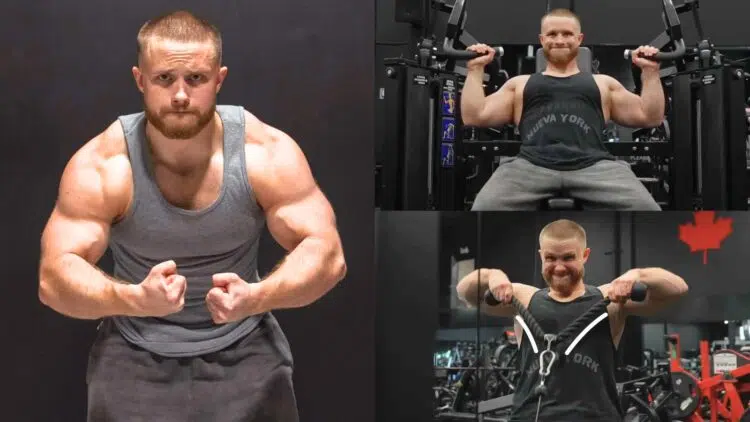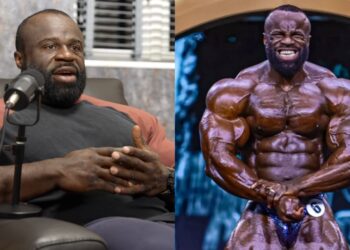Natural bodybuilder and powerlifter Jeff Nippard is taking the guesswork out of making exercise selections. In a recent YouTube video shared on September 10, 2024, Nippard ranked 21 of the best and worst movements for growing the shoulders, offering insight and justifications based on effectiveness using his criteria.
Making time for the gym can be a challenge in itself, but maximizing results while you’re there is sometimes even more difficult. That’s where fitness coach Jeff Nippard comes in. With years of experience competing in multiple disciplines, he’s acquired an impressive foundation of knowledge which he applies to the gym in each of his training sessions.
Nippard has offered his detailed breakdowns of the best and worst exercises for the quads, chest, back, triceps, and now we can add shoulders to the list. His criteria are simple: the exercises must offer a good stretch, high tension, and a smooth resistance profile, with the potential for progression over time.
Jeff Nippard’s Criteria for an Effective Shoulder Exercise
- Stretch and high tension
- It needs to feel good (no shoulder pain and smooth resistance profile)
- Simple progression (ability to add weights or reps over time)
The Three Heads of the Shoulder Muscle
- Anterior head
- Lateral head
- Posterior head
Nippard’s Ranking System
S tier – My favorite. Do them if you can.
A tier – Strongly recommend.
B tier – I still do these in certain contexts. There may be better options.
C tier – There are better options for most people. Can still have value in some contexts.
D tier – Probably not a great option for most people.
F tier – Generally not recommended.
Level Up Your Fitness: Join our 💪 strong community in Fitness Volt Newsletter. Get daily inspiration, expert-backed workouts, nutrition tips, the latest in strength sports, and the support you need to reach your goals. Subscribe for free!
Standing Dumbbell Lateral Raise – B Tier
“I like the dumbbell lateral raise because it’s super simple and you can get them done quickly. You can grab a pair of dumbbells a lot faster than you can set up a cable, especially if you do cables one arm at a time. So I do think they are the most time-efficient shoulder exercise but I don’t think they’re the most effective shoulder exercise. That’s because you have zero tension on your side delts at the bottom when they’re most stretched.”
“Despite this limitation, they will still clearly grow your shoulders,” adds Jeff Nippard.
Lean-In Dumbbell Lateral Raise – A Tier
“If you lean against something, like a bench or a rack, you suddenly modify the resistance curve to place more tension on your side delt when it’s most stretched. I think this is the most effective way to do lateral raises with dumbbells.”
Lean-Away Dumbbell Lateral Raise – B Tier
“Leaning away might shift some emphasis away from the muscles of the rotator cuff and on to the lateral delt depending on how you interpret this study but it still has the issue of not placing high enough tension in the stretched position.”
Super ROM Lateral Raise – B Tier
“I picked these up from Dr. Mike Israetel when we trained shoulders together and man, they definitely lit my delts up. I think it’s a very rare movement where you actually get the side delt fully contracted. I like that.”
“I think these are worth trying. That said, because they have the same resistance curve issues as the standard dumbbell lateral raise, they are not quite good enough to get into A tier.”
Overhead Press – B Tier+
“It does have two downsides: for one, it’s very anterior delt-dominant. When we look at activation patterns across the delt heads, you see that the side and rear heads aren’t activated much with the overhead press. And for two, because you’re standing, it’s not the most stable. This means your lower body and your core will have to work to keep your balance which will shift some tension coming from the bar away from your shoulders.”
Seated Overhead Press – B Tier
“If you do them seated, you do fix the stability issue since you no longer have to worry about your balance but since they are still very front-delt dominant, and there’s something about the seated OHP that just isn’t as satisfying as the standing OHP, I’m going to leave these in B tier as well.”
Dumbbell Overhead Press – A Tier
“You can get your sets done faster. You can grab a pair of dumbbells a lot faster than you can set up a barbell. For two, you can get a bit more range of motion both at the bottom and at the top especially if you allow the dumbbells to converge. And three, I think you’ll get a little more side delt involvement with dumbbells because they have to activate to keep the dumbbells from falling forward or backward.”
Machine Shoulder Press – A Tier+ (Nippard’s #1 Exercise for Front Delts)
“A personal favorite. If you can find a good machine that gets your delts into a deep stretch, I do find that it feels better than dumbbells and also since it’s less dependent on technique and coordination, you can get your delts all the way to failure without losing control of the weight.
It’s still going to be very front delt-dominant but as a vertical pressing option for hypertrophy, this is usually my go-to these days.”
‘Arnold Style’ Side Lying Dumbbell Raise – A Tier
“It looks a bit odd but I actually really like it. Unlike a standing dumbbell lateral raise, you get high tension while your delt is stretched and because you’re locked in against a bench, you’ll be nice and stable. You’ll get a huge range of motion and you should get a great side delt pump here.”
Front Raises – D Tier
“For the record, front raises of any kind, so dumbbell, cable, or machine, are all going in D tier.”
Get Fitter, FasterLevel Up Your Fitness: Join our 💪 strong community in Fitness Volt Newsletter. Get daily inspiration, expert-backed workouts, nutrition tips, the latest in strength sports, and the support you need to reach your goals. Subscribe for free!
Atlantis Standing Machine Lateral Raise – A Tier+
“It feels so smooth and you get this even consistent tension on the side delts throughout the range of motion. It’s easy to add a little weight or a rep from week to week.”
“The only minor snag is since you can’t move your arms across the body, you won’t get quite as good of a stretch as you would with cables or the Arnold lying raise.”
Seated Machine Lateral Raise – B Tier
“For whatever reason, having the pads higher up on my arms doesn’t feel quite as good. That might be because the moment arm to the shoulder is so short that I have to load it with more weight and that actually cranks my shoulders a bit.”
Cable Lateral Raise – S Tier (Nippard’s #1 Exercise for Side Delts)
“As long as you set the cable around hand height, it will provide maximum tension on the side delt while it’s most stretched,” said Nippard. “I find that cable lateral raise just feels excellent. You get that nice even tension on your side delts throughout the range of motion.”
Cable Y-Raise – S Tier
“It actually gives you an even bigger range of motion where you sweep the cable up and out and back and it’s also going in S tier.”
Behind-The-Back Cuffed Lateral Raise – S Tier
“I think it’s amazing. Its main advantage over the standard cable lateral raise is you get to knock out both arms at once which is twice as time-efficient.”
Banded Lateral Raise – C Tier
“I rarely include it these days. Similar to the dumbbell lateral raise, it provides zero tension in the stretch and maximum tension at the top. Unless all you have is a band, I do think dumbbells, cables, or machine laterals would be a better choice.”
Upright Row – D Tier
“It’s going to target both the upper traps and the side delts with a little bit of biceps involvement. I prefer to do these on cables with a rope because I can sweep the handles out as I row. As long as you have healthy shoulders, there’s no evidence that they contribute to shoulder issues.”
Reverse Pec Deck – S Tier
“It provides consistent tension throughout the range of motion and because your chest is braced, you’ll be directing all that tension coming from the stack into your rear delts. I actually prefer to do these sitting sideways because you’ll get a much deeper stretch.”
Rope Facepull – A Tier
“The rope face pull will target the rear delts really well, especially if you set up the rope a little lower, take an underhand grip, and externally rotate your shoulders as you pull.”
“My minor gripe though is it’s just really hard to not get your mid traps to take over.”
Bent Over Reverse Dumbbell Flye – B Tier
“Zero tension at the bottom when the delts are stretched. I still think they are a good option if you don’t have access to cables or if you are really time-restrained,” said Nippard.
Reverse Cable Crossover – S Tier (Nippard’s #1 Exercise for Rear Delts)
“Amazing stretch on your rear delts especially if you cross your arms over at the top. Enormous range of motion with nice even tension throughout the range.
As long as you hold the cables themselves and not the handles, it should feel nice and smooth and you shouldn’t run into a clanging as the arms cross over.”
Worst Exercise: Front Raise
Best Exercise: Cable Lateral Raise
Nippard’s Top 3 Best Exercises for Front, Side, and Rear Delt Growth:
- Machine Shoulder Press for Front Delts
- Cable Lateral Raise for Side Delts
- Reverse Cable Crossover for Rear Delts
From common bench pressing mistakes to his thoughts on steroid use, Jeff Nippard is committed to offering consumers free and insightful workout information. The next time you hit the gym for shoulders, use his list to craft the ultimate workout!
RELATED: Jeff Nippard Reveals If Free Weights Are Better Than Machines for Building Muscle
Watch the full video from Jeff Nippard’s YouTube channel below:









